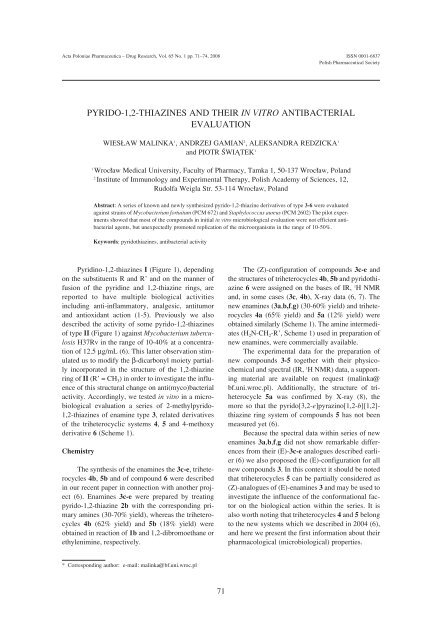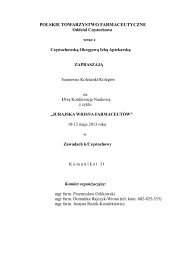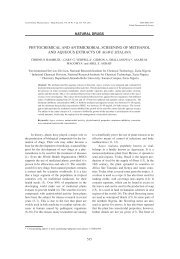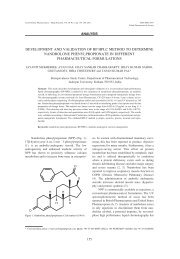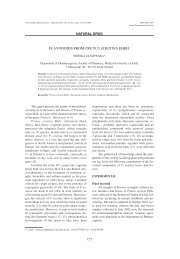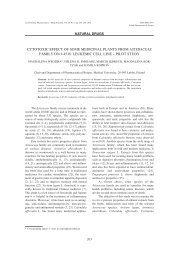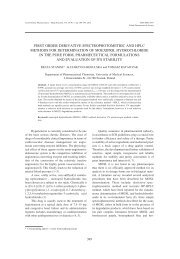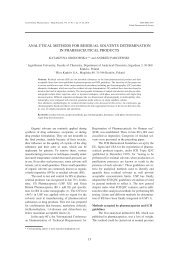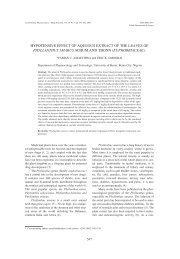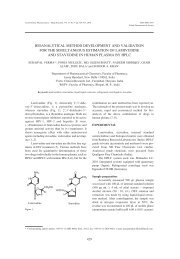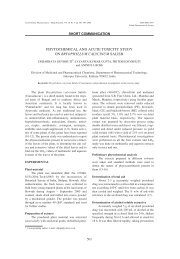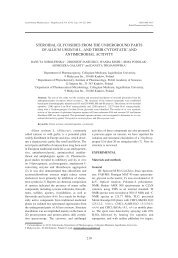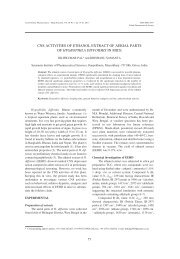pyrido-1,2-thiazines and their in vitro antibacterial evaluation
pyrido-1,2-thiazines and their in vitro antibacterial evaluation
pyrido-1,2-thiazines and their in vitro antibacterial evaluation
You also want an ePaper? Increase the reach of your titles
YUMPU automatically turns print PDFs into web optimized ePapers that Google loves.
Acta Poloniae Pharmaceutica ñ Drug Research, Vol. 65 No. 1 pp. 71ñ74, 2008 ISSN 0001-6837<br />
Polish Pharmaceutical Society<br />
PYRIDO-1,2-THIAZINES AND THEIR IN VITRO ANTIBACTERIAL<br />
EVALUATION<br />
WIES£AW MALINKA 1 , ANDRZEJ GAMIAN 2 , ALEKSANDRA REDZICKA 1<br />
<strong>and</strong> PIOTR åWI•TEK 1<br />
1<br />
Wroc≥aw Medical University, Faculty of Pharmacy, Tamka 1, 50-137 Wroc≥aw, Pol<strong>and</strong><br />
2<br />
Institute of Immunology <strong>and</strong> Experimental Therapy, Polish Academy of Sciences, 12,<br />
Rudolfa Weigla Str. 53-114 Wroc≥aw, Pol<strong>and</strong><br />
Abstract: A series of known <strong>and</strong> newly synthesized <strong>pyrido</strong>-1,2-thiaz<strong>in</strong>e derivatives of type 3-6 were evaluated<br />
aga<strong>in</strong>st stra<strong>in</strong>s of Mycobacterium fortuitum (PCM 672) <strong>and</strong> Staphylococcus aureus (PCM 2602) The pilot experiments<br />
showed that most of the compounds <strong>in</strong> <strong>in</strong>itial <strong>in</strong> <strong>vitro</strong> microbiological <strong>evaluation</strong> were not efficient <strong>antibacterial</strong><br />
agents, but unexpectedly promoted replication of the microorganisms <strong>in</strong> the range of 10-50%.<br />
Keywords: <strong>pyrido</strong><strong>thiaz<strong>in</strong>es</strong>, <strong>antibacterial</strong> activity<br />
Pyrid<strong>in</strong>o-1,2-<strong>thiaz<strong>in</strong>es</strong> I (Figure 1), depend<strong>in</strong>g<br />
on the substituents R <strong>and</strong> Rí <strong>and</strong> on the manner of<br />
fusion of the pyrid<strong>in</strong>e <strong>and</strong> 1,2-thiaz<strong>in</strong>e r<strong>in</strong>gs, are<br />
reported to have multiple biological activities<br />
<strong>in</strong>clud<strong>in</strong>g anti-<strong>in</strong>flammatory, analgesic, antitumor<br />
<strong>and</strong> antioxidant action (1-5). Previously we also<br />
described the activity of some <strong>pyrido</strong>-1,2-<strong>thiaz<strong>in</strong>es</strong><br />
of type II (Figure 1) aga<strong>in</strong>st Mycobacterium tuberculosis<br />
H37Rv <strong>in</strong> the range of 10-40% at a concentration<br />
of 12.5 µg/mL (6). This latter observation stimulated<br />
us to modify the β-dicarbonyl moiety partially<br />
<strong>in</strong>corporated <strong>in</strong> the structure of the 1,2-thiaz<strong>in</strong>e<br />
r<strong>in</strong>g of II (Rí = CH 3 ) <strong>in</strong> order to <strong>in</strong>vestigate the <strong>in</strong>fluence<br />
of this structural change on anti(myco)bacterial<br />
activity. Accord<strong>in</strong>gly, we tested <strong>in</strong> <strong>vitro</strong> <strong>in</strong> a microbiological<br />
<strong>evaluation</strong> a series of 2-methyl<strong>pyrido</strong>-<br />
1,2-<strong>thiaz<strong>in</strong>es</strong> of enam<strong>in</strong>e type 3, related derivatives<br />
of the triheterocyclic systems 4, 5 <strong>and</strong> 4-methoxy<br />
derivative 6 (Scheme 1).<br />
Chemistry<br />
The synthesis of the enam<strong>in</strong>es the 3c-e, triheterocycles<br />
4b, 5b <strong>and</strong> of compound 6 were described<br />
<strong>in</strong> our recent paper <strong>in</strong> connection with another project<br />
(6). Enam<strong>in</strong>es 3c-e were prepared by treat<strong>in</strong>g<br />
<strong>pyrido</strong>-1,2-thiaz<strong>in</strong>e 2b with the correspond<strong>in</strong>g primary<br />
am<strong>in</strong>es (30-70% yield), whereas the triheterocycles<br />
4b (62% yield) <strong>and</strong> 5b (18% yield) were<br />
obta<strong>in</strong>ed <strong>in</strong> reaction of 1b <strong>and</strong> 1,2-dibromoethane or<br />
ethylenim<strong>in</strong>e, respectively.<br />
The (Z)-configuration of compounds 3c-e <strong>and</strong><br />
the structures of triheterocycles 4b, 5b <strong>and</strong> <strong>pyrido</strong>thiaz<strong>in</strong>e<br />
6 were assigned on the bases of IR, 1 H NMR<br />
<strong>and</strong>, <strong>in</strong> some cases (3c, 4b), X-ray data (6, 7). The<br />
new enam<strong>in</strong>es (3a,b,f,g) (30-60% yield) <strong>and</strong> triheterocycles<br />
4a (65% yield) <strong>and</strong> 5a (12% yield) were<br />
obta<strong>in</strong>ed similarly (Scheme 1). The am<strong>in</strong>e <strong>in</strong>termediates<br />
(H 2 N-CH 2 -Rí, Scheme 1) used <strong>in</strong> preparation of<br />
new enam<strong>in</strong>es, were commercially available.<br />
The experimental data for the preparation of<br />
new compounds 3-5 together with <strong>their</strong> physicochemical<br />
<strong>and</strong> spectral (IR, 1 H NMR) data, a support<strong>in</strong>g<br />
material are available on request (mal<strong>in</strong>ka@<br />
bf.uni.wroc.pl). Additionally, the structure of triheterocycle<br />
5a was confirmed by X-ray (8), the<br />
more so that the <strong>pyrido</strong>[3,2-e]pyraz<strong>in</strong>o[1,2-b][1,2]-<br />
thiaz<strong>in</strong>e r<strong>in</strong>g system of compounds 5 has not been<br />
measured yet (6).<br />
Because the spectral data with<strong>in</strong> series of new<br />
enam<strong>in</strong>es 3a,b,f,g did not show remarkable differences<br />
from <strong>their</strong> (E)-3c-e analogues described earlier<br />
(6) we also proposed the (E)-configuration for all<br />
new compounds 3. In this context it should be noted<br />
that triheterocycles 5 can be partially considered as<br />
(Z)-analogues of (E)-enam<strong>in</strong>es 3 <strong>and</strong> may be used to<br />
<strong>in</strong>vestigate the <strong>in</strong>fluence of the conformational factor<br />
on the biological action with<strong>in</strong> the series. It is<br />
also worth not<strong>in</strong>g that triheterocycles 4 <strong>and</strong> 5 belong<br />
to the new systems which we described <strong>in</strong> 2004 (6),<br />
<strong>and</strong> here we present the first <strong>in</strong>formation about <strong>their</strong><br />
pharmacological (microbiological) properties.<br />
* Correspond<strong>in</strong>g author: e-mail: mal<strong>in</strong>ka@bf.uni.wroc.pl<br />
71
72 WIES£AW MALINKA et al.<br />
Scheme 1.<br />
MICROBIOLOGY<br />
Materials <strong>and</strong> Methods<br />
Bacterial stra<strong>in</strong>s <strong>and</strong> grow<strong>in</strong>g conditions<br />
The stra<strong>in</strong>s of Mycobacterium fortuitum (PCM<br />
672) <strong>and</strong> Staphylococcus aureus (PCM 2602)<br />
(obta<strong>in</strong>ed from the Polish Collection of<br />
Microorganisms (PCM) of the Institute of<br />
Immunology <strong>and</strong> Experimental Therapy, Polish<br />
Academy of Sciences) were used throughout the<br />
study. Bacteria were cultivated on liquid 79 culture<br />
medium (for M. fortuitum), Luria-Bertani (LB)<br />
medium (for S. aureus) at 37 O C for 24 h under aero-
Pyrido-1,2-<strong>thiaz<strong>in</strong>es</strong> <strong>and</strong> <strong>their</strong> <strong>in</strong> <strong>vitro</strong> <strong>antibacterial</strong> <strong>evaluation</strong> 73<br />
Figure 1.<br />
bic conditions. Then bacterial cells were diluted<br />
with the same media, respectively, to obta<strong>in</strong> suspensions<br />
of about 2 ◊ 10 5 cfu/mL of each stra<strong>in</strong>.<br />
Antibacterial succeptibility test<br />
The <strong>antibacterial</strong> activities of synthesized compounds<br />
were determ<strong>in</strong>ed aga<strong>in</strong>st bacterial stra<strong>in</strong>s by<br />
the microplate Alamar Blue assay accord<strong>in</strong>g to<br />
Ahmed et al. (9). Stock solutions of the compounds<br />
were prepared <strong>in</strong> DMSO (1 mg/mL) <strong>and</strong> were diluted<br />
with appropriate media <strong>in</strong> the range 0.03 ñ 1000<br />
µg/mL on cell culture microtitration plate. To the<br />
wells conta<strong>in</strong><strong>in</strong>g 100 µL of drug compound, aliquots<br />
of 100 µL of the diluted suspension of the stra<strong>in</strong><br />
were added. The control wells consist<strong>in</strong>g of either<br />
bacteria only or medium only <strong>and</strong> those conta<strong>in</strong><strong>in</strong>g<br />
different drug concentrations (100 µL) were <strong>in</strong>oculated<br />
with 100 µL of the diluted bacterial cells.<br />
Plates were <strong>in</strong>cubated at 37 O C for 48 h <strong>and</strong> after that<br />
20 µL of Alamar Blue (10◊ diluted) <strong>and</strong> 12.5 µL of<br />
20% Tween 80 solutions were added to the wells<br />
<strong>and</strong> <strong>in</strong>cubation was cont<strong>in</strong>ued at 37 O C for 2 h.<br />
Fluorescence was measured us<strong>in</strong>g Victor apparatus<br />
(Wallac, Perk<strong>in</strong> Elmer). The experiment was repeated<br />
two- or three-fold. The m<strong>in</strong>imal <strong>in</strong>hibitory concentration<br />
(MIC) was def<strong>in</strong>ed as the lowest drug<br />
concentration which prevented a color change from<br />
blue to p<strong>in</strong>k, <strong>in</strong>hibit<strong>in</strong>g the bacterial growth for =<br />
90%. The means <strong>and</strong> st<strong>and</strong>ard error values were<br />
determ<strong>in</strong>ed us<strong>in</strong>g Statistica program.<br />
RESULTS AND DISCUSSION<br />
All compounds 3-6 shown <strong>in</strong> Scheme 1, except<br />
5a, which was isolated at a very low yield (12%),<br />
were evaluated aga<strong>in</strong>st Mycobacterium fortuitum<br />
PCM 652 <strong>and</strong> Staphylococcus aureus PCM 2602.<br />
The literature suggests that the activity of, for example,<br />
ch<strong>in</strong>olone derivatives aga<strong>in</strong>st M. fortuitum correlate<br />
closely with the activity aga<strong>in</strong>st M. tuberculosis<br />
(10). Therefore <strong>in</strong> our experiments the less hazardous<br />
microorganism M. fortuitum was used to<br />
evaluate the anti-Mycobacterium tuberculosis activity<br />
of our compounds 3-6.<br />
Isoniazide was used as a st<strong>and</strong>ard <strong>in</strong> the test<br />
aga<strong>in</strong>st Mycobacterium. fortuitum, whereas ery-<br />
Table 1. Effects of the compounds 3-6 on Mycobacterium fortuitum (PCM 672) <strong>and</strong> Staphylococcus aureus (PCM 2602) growth.<br />
No.<br />
Mycobacterium fortuitum<br />
Staphylococcus aureus<br />
No.<br />
10% mg/mL* 10-50% mg/mL** 10% mg/mL* 10-50% mg/mL**<br />
3c 0.45 15.6 3a 7.8<br />
3d 0.03 250*** 3b 250<br />
3e 7.8 125 3e 31.25<br />
4a 0.45 125 3f 31.25 250<br />
4b 0.03 250 3g 0.45 62.5<br />
5b 1.95 250 4a 3.9<br />
4b 3.9 62.5<br />
Concentration required to <strong>in</strong>crease the number of bacteria by: 50%***
74 WIES£AW MALINKA et al.<br />
tromyc<strong>in</strong>e was a reference drug <strong>in</strong> <strong>evaluation</strong> of<br />
compounds aga<strong>in</strong>st Staphylococcus aureus.<br />
All compounds evaluated aga<strong>in</strong>st M. fortuitum<br />
either demonstrated any <strong>in</strong>hibitory activity at the<br />
MIC 50 <strong>and</strong> MIC 90 levels, even at the maximal<br />
employed concentration (250 mg/mL), or <strong>their</strong> limited<br />
solubility prohibited an accurate determ<strong>in</strong>ation.<br />
MIC 50 for isoniazide was < 1 µg/mL, while the<br />
MIC 90 vale for this drug was greater than 250 µg/mL.<br />
However, to our complete surprise, all of the compounds<br />
tested helped to stimulate the growth of the<br />
Mycobacterium fortuitum stra<strong>in</strong> (Table 1). The best<br />
stimulant was 3d, which promoted the growth of the<br />
microorganisms > 50%, however, the maximal effect<br />
was observed only at the highest concentration used<br />
(250 µg/mL). For the rema<strong>in</strong><strong>in</strong>g compounds shown<br />
<strong>in</strong> Table 1, the maximal stimulation of growth of M.<br />
fortuitum was found with<strong>in</strong> the range of 10-50% at<br />
different concentrations for <strong>in</strong>dividual compounds<br />
(e.g. 3c ñ 15.6 µg/mL, 5b ñ 250 mg/mL). It should<br />
be noted that the replication stimulat<strong>in</strong>g effect on the<br />
microorganisms at the < 10% level was observed at<br />
sub-mg/mL concentrations (0.03-0.45 µg/mL) for<br />
most of the compounds <strong>in</strong> Table 1. The other compounds<br />
(3a,b,f,g,h, 6) tested aga<strong>in</strong>st Mycobacterium<br />
fortuitum exhibited weak stimulation (below 10%),<br />
<strong>and</strong> only after application of the preparations at the<br />
maximal concentration used (250 µg/mL, data not<br />
shown). Compounds 3-6 were also evaluated aga<strong>in</strong>st<br />
a stra<strong>in</strong> of Staphylococcus aureus (PCM 2602), however,<br />
all of them were devoid of <strong>antibacterial</strong> action<br />
at the MIC 50 as well as the MIC 90 level, even at the<br />
maximal concentration used (250 µg/mL). MIC 50/90<br />
values for erytromyc<strong>in</strong>, used as a st<strong>and</strong>ard <strong>in</strong> this test,<br />
were below 1 µg/mL. However, as <strong>in</strong> the case of M.<br />
fortuitum, the compounds enhanced the replication of<br />
S. aureus. The best stimulants of growth of these<br />
microorganisms were 3g, 4b <strong>and</strong> 3f, which enhanced<br />
replication of the bacteria at levels of 10-50% (Table<br />
1). The rema<strong>in</strong><strong>in</strong>g compounds shown at Table 1<br />
(3a,b,e, 4a) <strong>and</strong> the preparations 3c, 3d <strong>and</strong> 5b (data<br />
not shown) revealed only weak stimulation (< 10%)<br />
observed at varied concentrations for <strong>in</strong>dividual<br />
compounds [e.g. 3.9 µg/mL (4a), 250 µg/mL (3b)].<br />
The only compound which did not stimulate the<br />
growth of S. aureus was the non-enam<strong>in</strong>e <strong>pyrido</strong>-1,2-<br />
thiaz<strong>in</strong>e 6.<br />
The mechanism by which the preparations 3-5<br />
<strong>in</strong>crease the growth of M. fortuitum.<strong>and</strong> S. aureus is<br />
unclear. On the one h<strong>and</strong>, it cannot be ruled out that<br />
the bacteria are able to utilize nitrogen-conta<strong>in</strong><strong>in</strong>g<br />
fragments from the enam<strong>in</strong>e moieties of 3 <strong>and</strong> triheterocyle<br />
5b for replication. This may be partially<br />
supported by the fact that the non-enam<strong>in</strong>e <strong>pyrido</strong>-<br />
1,2-thiaz<strong>in</strong>e 6 was the only preparation which practically<br />
did not promote the growth of microorganisms.<br />
On the other h<strong>and</strong>, stimulation was also<br />
observed <strong>in</strong> the case of trihetrocycles 4 which, similar<br />
to 6, are devoid of enam<strong>in</strong>e nitrogen.<br />
It is also unclear if the <strong>in</strong>crease <strong>in</strong> bacterial<br />
replication observed at low concentration (below 1<br />
µg/mL; Table 1) is a consequence of an enhancement<br />
of bacterial growth by the compounds or <strong>their</strong><br />
lack of activity to allow on the natural growth of the<br />
microorganisms.<br />
On the basis of the above pilot data it may be<br />
concluded that modification of the β-dicarbonyl substructure<br />
of the weak antimycobacterial agents of 3-<br />
acyl-4-hydroxy<strong>pyrido</strong>-1,2-thiaz<strong>in</strong>e type II (Figure 1)<br />
does not seem to offer an <strong>antibacterial</strong> specific group.<br />
REFERENCES<br />
1. Toa Eiyo Kagaku Kogyo, pat. Jap., 8436685<br />
(1984); C.A. 101, 7177a.<br />
2. Saito K., Okutani K.: Yakugaku Zasshi, 106<br />
(1008) 1986; C.A. 107, 77727c.<br />
3. Zawisza T., Mal<strong>in</strong>ka W.: Farmaco 41, 892<br />
(1986).<br />
4. Mal<strong>in</strong>ka W., Kaczmarz M., Filipek B., Sapa J.,<br />
G≥Ûd B.: Farmaco 57, 737 (2002).<br />
5. Mal<strong>in</strong>ka W., Kaczmarz M., Redzicka A.: Acta<br />
Pol.. Pharm.Drug Res. 61, 100 (2004).<br />
6. Mal<strong>in</strong>ka W., Karczmarzyk Z., Kaczmarz M.,<br />
åwiπtek P., UrbaÒczyk-Lipkowska Z.: Pol. J.<br />
Chem. 78, 815 (2004).<br />
7. Karczmarzyk Z., Mal<strong>in</strong>ka W.: Acta Cryst. E61,<br />
1649 (2005).<br />
8. Karczmarzyk Z., Mal<strong>in</strong>ka W.: Acta Cryst. E62,<br />
5781 (2006).<br />
9. Ahmed S.A., Gogal R.M., Walsh J.E.: J.<br />
Immunol. Meth. 170, 211 (1994).<br />
10. Remau T., Sanchez J., Shapiro M., Dever J.,<br />
Gracheck S., Domagala J.: J. Med. Chem. 38,<br />
2974 (1995).


